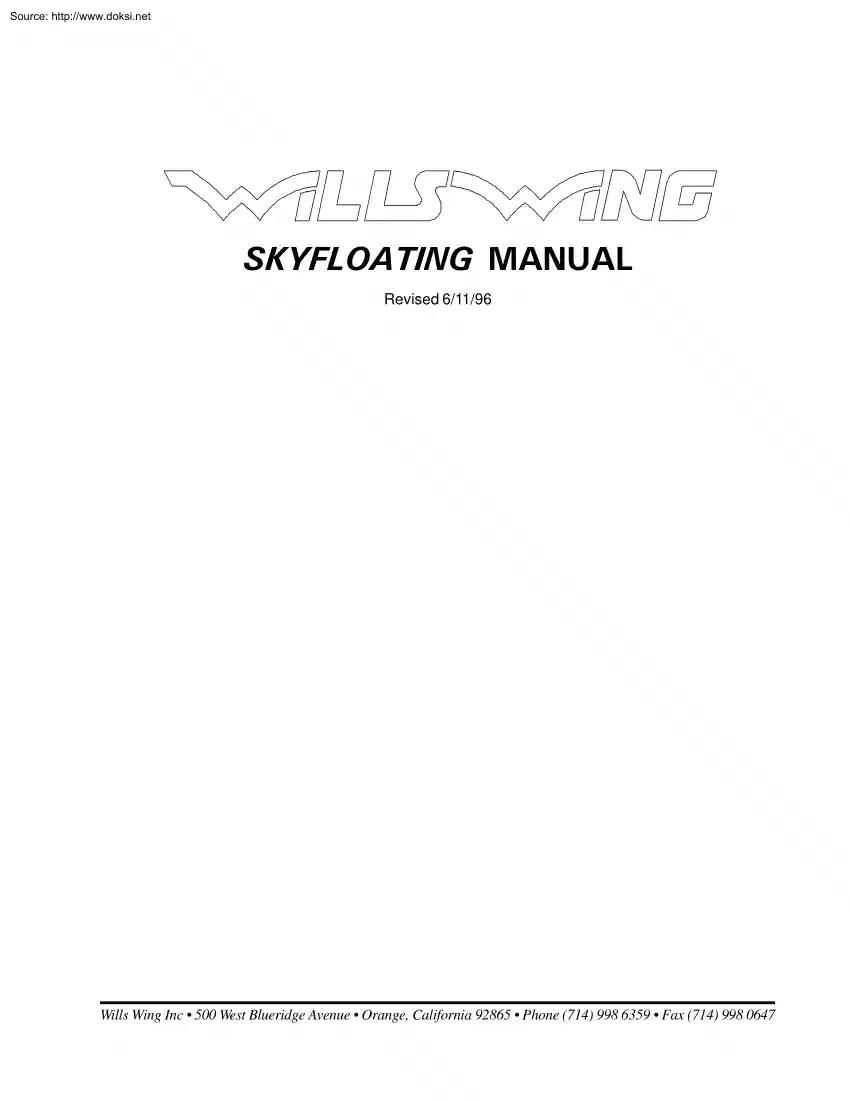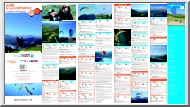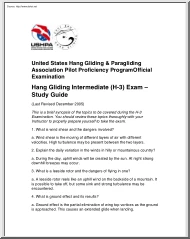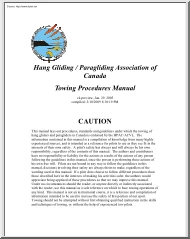Datasheet
Year, pagecount:1996, 4 page(s)
Language:English
Downloads:2
Uploaded:September 10, 2018
Size:538 KB
Institution:
-
Comments:
Wills Wing Inc
Attachment:-
Download in PDF:Please log in!
Comments
No comments yet. You can be the first!Content extract
Source: http://www.doksinet SKYFLOATING MANUAL Revised 6/11/96 Wills Wing Inc • 500 West Blueridge Avenue • Orange, California 92865 • Phone (714) 998 6359 • Fax (714) 998 0647 Source: http://www.doksinet Why Skyfloat It’s new, easy, and it’s FUN! Many hang glider pilots have given up flying because of lower back problems, being tired of the hassle of setup, or the lack of forgiveness in many new high performance designs. Many paraglider pilots find themselves unable to launch due to high winds, or unsuitable launch areas. The Falcon in conjunction with the Skyfloating bar solves many of these problems. History Our European distributor introduced the Wills Wing Falcon as a craft that has flight characteristics somewhere between a hang glider and paraglider. At the same time we were developing a spreader bar attachment that would allow a paraglider pilot to use his or her paragliding harness, emergency reserve, and instruments, to learn how to hang glide. We joined the
two concepts and “Skyfloating” was born. Caution: This is not intended to be a “How to fly manual”. This is a brief summary about Skyfloating. It presupposes a thorough knowledge of meteorology, hang glider setup, launch, landing, control, etc. We advise you to get instruction from a certified hang gliding instructor to learn the sport of Skyfloating. The Wills Wing Skyfloating spreader bar was developed to allow the use of a two point suspension paraglider harness to be flown inside the control bar suprone (supine / prone) on a Wills Wing Falcon. Setting Up The Skyfloating Bar For Flight The Skyfloating bar comes assembled with webbing that is secured to a curved one inch tube by four grommets. The webbing has Velcro retainers for routing your parachute bridle. We did not include the necessary steel carabiner, aluminum carabiners, or bridle extension with the assembly as many pilots have some or all of these items already. 1) Attach a steel carabiner to the top of the
webbing. Put the carabiner between the sewn bar tacks at the top of the assembly to keep it centered with the gate of the carabiner facing forward. We recommend the use of a steel carabiner rated for 11,000 pounds, (5000 kilos) at the top of the spreader for the main attachment to the gliders hang loop. Caution; Be sure that you are hanging from the Type 18 (thick) webbing. 2) Secure the parachute bridle to the back of the steel carabiner. Use a rubber band retainer to keep it in place. This ensures that the parachute bridle cannot put load on the gate of the carabiner. Caution: It is very important that the emergency reserve parachute bridle be attached to the carabiner at the top of the Skyfloating bar. This is to insure that the pilot and glider are suspended at the hang loop on the glider’s keel in the event of an of an emergency deployment. If the normal paragliding parachute attachment to the pilot’s shoulders is used, the opening shock could slam the pilot into the
structure of the glider. 3) Install bridle extension if needed. Caution: If the Skyfloating spreader bar is used with a paraglider emergency reserve parachute (short bridle), it is very important that you use a bridle extension. Your parachute bridle should be a minimum of twenty feet long. Twenty five feet is preferred (Most paraglider emergency reserve parachutes utilize a bridle that is between one and four feet long.) The bridle must be long enough to clear the span of the glider in the event of an emergency deployment. Remember to detach the harness bridle from the parachute when you install the bridle extension, or the extension will serve no purpose. 4) Set your hang height in the Falcon. The Skyfloating spreader bar provides four different hang heights, with a total of seven inches of adjustment. This range covers a wide variety of harness and carabiner designs. You select a hang height by attaching the carabiners to one of the loops in the webbing at the bottom of the
assembly above or below the twin sewn bar tacks. The higher you hang above the base tube, the more flair authority you’ll have, and the less roll control you’ll have. Select Source: http://www.doksinet hook in points that put the bottom of your harness just above the base tube when you are pulled in over the bar. 5) Adjust your harness We recommend that you adjust your harness upright (not reclined severely) so that the downtubes of the control frame are in a comfortable position at the normal trim speed of the glider. Caution: The Skyfloating bar has been flight tested in the Falcon series gliders with factory stock hang loops. Any change to the length of the hang loop, or use on other glider designs could compromise the operation of the Skyfloating bar. First Skyfloating Flights Even if you have previous hang gliding experience, we recommend that you make your first launches, flights, and landings on a small hill with the Skyfloating bar behind you. You accomplish this by
putting your arms in between the two webbing suspension straps before grasping the downtubes. (This puts the entire assembly behind you). In this configuration the glider controls and feels the same as it does with a normal prone hang gliding harness. On your first flights it is best to let your Falcon fly at trim with your hands on the uprights of the control bar. Use small control inputs to do your first turns Caution: We advise you to get instruction from a certified hang gliding instructor to learn the sport of Skyfloating. It will be easier to make your first Falcon flights in a hang gliding training harness so you won’t have to deal with the Skyfloating bar until you have mastered the control of the glider. Later Skyfloating Flights After you have practiced launches, short flights, turns and landings in the “in front” position and graduate to a higher flying site, you can transition to the “in back” position. Practice the transition in a simulator so it is not a new
experience for you. Be sure that you are safely away from the hill and all obstructions, and with the glider flying at trim, let go of the control bar, put your elbows together to transition to the back side of the suspension straps, sit back in your harness, and re-grasp the downtubes. Congratulations, you are now Skyfloating! Bar Positions And Speeds While holding the downtubes from the “in back” position, your arms will be bent about 30 degrees at trim, flying wings level. (Providing your harness is properly adjusted.) You’ll need nearly full arm extension to coordinate a circling 45 degree turn. Putting your legs on the front side of the base tube, and pulling your body forward to the point that your butt is over the bar, will yield a speed faster than you can attain prone. The wing tufts (yarns) on the top surface of the glider are very helpful on early flights to find what bar position corresponds to the first onset of flow separation, or stall. See your Falcon Owner’s
Manual for a complete explanation on the use of wing tufts. On later flights you will be able to use your feet to fly the glider if you wish. Caution: Do not rest your feet on the control bar base tube on early flights. Placing your feet on the bar takes feedback on what the glider is doing away from your hands. It Feels Different At First Pilots that have no prior experience with seated or suprone flying will find this position a bit strange at first. It will take most pilots several hours of air time to get use to flying this way. Visibility Because you are sitting closer to the sail on the Falcon while Skyfloating than you are when flying prone, there is a loss of visibility when you are thermaling. Caution: Be very careful to clear all your turns when flying. When you are in a banked attitude you can not see a glider at the same altitude on the other side of the thermal. Landing In Front We recommend that you land “in front” of the Skyfloating bar. You will have more flair
authority than in a normal prone harness if you transition to the “in front” position prior to landing. Source: http://www.doksinet To Transition From In Back To In Front Be sure that you do the transition high enough above the landing area that you have plenty of time. With the glider flying at trim, let go of the control bar, put your elbows together, transition to the “in front” position, and re-grasp the downtubes. Landing Behind It is possible to land the Falcon in the “in back” position. You will have less flair authority “in back”, but it is sufficient if there is any wind. Pilots that are experienced with the rear wire flair method will find that it works well from the “in back” position. Caution: This Skyfloating bar has been structurally tested to 1600 pounds without failure or deformation. Additionally the individual webbing loops with grommets have been pull tested to failure at 4000 pounds per side. A total load of 8000 pounds (for both sides) is
enough load to fail four hang gliders simultaneously. It is however very important that you maintain the Skyfloating bar like you would any of the equipment that your life depends on. Replace the webbing on your Skyfloating bar once a year or anytime there is apparent wear. Fly Safely And Have Fun! Wills Wing Inc
two concepts and “Skyfloating” was born. Caution: This is not intended to be a “How to fly manual”. This is a brief summary about Skyfloating. It presupposes a thorough knowledge of meteorology, hang glider setup, launch, landing, control, etc. We advise you to get instruction from a certified hang gliding instructor to learn the sport of Skyfloating. The Wills Wing Skyfloating spreader bar was developed to allow the use of a two point suspension paraglider harness to be flown inside the control bar suprone (supine / prone) on a Wills Wing Falcon. Setting Up The Skyfloating Bar For Flight The Skyfloating bar comes assembled with webbing that is secured to a curved one inch tube by four grommets. The webbing has Velcro retainers for routing your parachute bridle. We did not include the necessary steel carabiner, aluminum carabiners, or bridle extension with the assembly as many pilots have some or all of these items already. 1) Attach a steel carabiner to the top of the
webbing. Put the carabiner between the sewn bar tacks at the top of the assembly to keep it centered with the gate of the carabiner facing forward. We recommend the use of a steel carabiner rated for 11,000 pounds, (5000 kilos) at the top of the spreader for the main attachment to the gliders hang loop. Caution; Be sure that you are hanging from the Type 18 (thick) webbing. 2) Secure the parachute bridle to the back of the steel carabiner. Use a rubber band retainer to keep it in place. This ensures that the parachute bridle cannot put load on the gate of the carabiner. Caution: It is very important that the emergency reserve parachute bridle be attached to the carabiner at the top of the Skyfloating bar. This is to insure that the pilot and glider are suspended at the hang loop on the glider’s keel in the event of an of an emergency deployment. If the normal paragliding parachute attachment to the pilot’s shoulders is used, the opening shock could slam the pilot into the
structure of the glider. 3) Install bridle extension if needed. Caution: If the Skyfloating spreader bar is used with a paraglider emergency reserve parachute (short bridle), it is very important that you use a bridle extension. Your parachute bridle should be a minimum of twenty feet long. Twenty five feet is preferred (Most paraglider emergency reserve parachutes utilize a bridle that is between one and four feet long.) The bridle must be long enough to clear the span of the glider in the event of an emergency deployment. Remember to detach the harness bridle from the parachute when you install the bridle extension, or the extension will serve no purpose. 4) Set your hang height in the Falcon. The Skyfloating spreader bar provides four different hang heights, with a total of seven inches of adjustment. This range covers a wide variety of harness and carabiner designs. You select a hang height by attaching the carabiners to one of the loops in the webbing at the bottom of the
assembly above or below the twin sewn bar tacks. The higher you hang above the base tube, the more flair authority you’ll have, and the less roll control you’ll have. Select Source: http://www.doksinet hook in points that put the bottom of your harness just above the base tube when you are pulled in over the bar. 5) Adjust your harness We recommend that you adjust your harness upright (not reclined severely) so that the downtubes of the control frame are in a comfortable position at the normal trim speed of the glider. Caution: The Skyfloating bar has been flight tested in the Falcon series gliders with factory stock hang loops. Any change to the length of the hang loop, or use on other glider designs could compromise the operation of the Skyfloating bar. First Skyfloating Flights Even if you have previous hang gliding experience, we recommend that you make your first launches, flights, and landings on a small hill with the Skyfloating bar behind you. You accomplish this by
putting your arms in between the two webbing suspension straps before grasping the downtubes. (This puts the entire assembly behind you). In this configuration the glider controls and feels the same as it does with a normal prone hang gliding harness. On your first flights it is best to let your Falcon fly at trim with your hands on the uprights of the control bar. Use small control inputs to do your first turns Caution: We advise you to get instruction from a certified hang gliding instructor to learn the sport of Skyfloating. It will be easier to make your first Falcon flights in a hang gliding training harness so you won’t have to deal with the Skyfloating bar until you have mastered the control of the glider. Later Skyfloating Flights After you have practiced launches, short flights, turns and landings in the “in front” position and graduate to a higher flying site, you can transition to the “in back” position. Practice the transition in a simulator so it is not a new
experience for you. Be sure that you are safely away from the hill and all obstructions, and with the glider flying at trim, let go of the control bar, put your elbows together to transition to the back side of the suspension straps, sit back in your harness, and re-grasp the downtubes. Congratulations, you are now Skyfloating! Bar Positions And Speeds While holding the downtubes from the “in back” position, your arms will be bent about 30 degrees at trim, flying wings level. (Providing your harness is properly adjusted.) You’ll need nearly full arm extension to coordinate a circling 45 degree turn. Putting your legs on the front side of the base tube, and pulling your body forward to the point that your butt is over the bar, will yield a speed faster than you can attain prone. The wing tufts (yarns) on the top surface of the glider are very helpful on early flights to find what bar position corresponds to the first onset of flow separation, or stall. See your Falcon Owner’s
Manual for a complete explanation on the use of wing tufts. On later flights you will be able to use your feet to fly the glider if you wish. Caution: Do not rest your feet on the control bar base tube on early flights. Placing your feet on the bar takes feedback on what the glider is doing away from your hands. It Feels Different At First Pilots that have no prior experience with seated or suprone flying will find this position a bit strange at first. It will take most pilots several hours of air time to get use to flying this way. Visibility Because you are sitting closer to the sail on the Falcon while Skyfloating than you are when flying prone, there is a loss of visibility when you are thermaling. Caution: Be very careful to clear all your turns when flying. When you are in a banked attitude you can not see a glider at the same altitude on the other side of the thermal. Landing In Front We recommend that you land “in front” of the Skyfloating bar. You will have more flair
authority than in a normal prone harness if you transition to the “in front” position prior to landing. Source: http://www.doksinet To Transition From In Back To In Front Be sure that you do the transition high enough above the landing area that you have plenty of time. With the glider flying at trim, let go of the control bar, put your elbows together, transition to the “in front” position, and re-grasp the downtubes. Landing Behind It is possible to land the Falcon in the “in back” position. You will have less flair authority “in back”, but it is sufficient if there is any wind. Pilots that are experienced with the rear wire flair method will find that it works well from the “in back” position. Caution: This Skyfloating bar has been structurally tested to 1600 pounds without failure or deformation. Additionally the individual webbing loops with grommets have been pull tested to failure at 4000 pounds per side. A total load of 8000 pounds (for both sides) is
enough load to fail four hang gliders simultaneously. It is however very important that you maintain the Skyfloating bar like you would any of the equipment that your life depends on. Replace the webbing on your Skyfloating bar once a year or anytime there is apparent wear. Fly Safely And Have Fun! Wills Wing Inc





